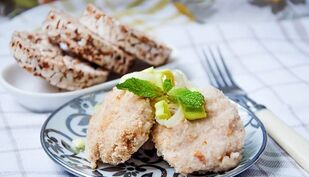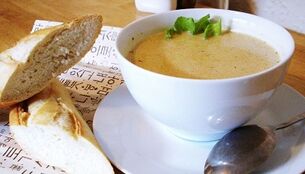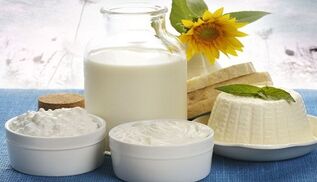
Pancreatitis is a serious disease of the pancreas, characterized by a violation of the production of digestive enzymes. The main symptoms of the disease are pain after eating left or right, heartburn, nausea, vomiting and upset stomach.
Strict adherence to the dietary guidelines is key to treating pancreatitis. After all, the development of the disease often occurs due to the improper lifestyle, the use of alcohol and the "junk food" in large quantities.
Diet for people with pancreatitis helps the patient relieve pain during exacerbations of the disease and further remission. In acute and chronic pancreatitis, nutrition is different, but it still has some similarities. Let's talk about them.
General nutritional rules for inflammatory pancreatitis
The main dietary requirement is to increase the amount of protein consumed and to reduce fats and carbohydrates in the main diet (if possible, they should be eliminated completely). In particular, you should forgo the consumption of granulated sugar, as it is composed of 99% carbohydrates.
High-fat meals are high in raw fiber and completely disappear from the life of a patient with pancreatitis. After all, they act on the pancreas, resulting in the organ starting to produce huge amounts of digestive enzymes, which is very dangerous in this disease and can lead to serious complications.
Doctors recommend that all patients with pancreatitis take a multivitamin to help fill the vitamin and mineral deficiencies in the body, often due to limited nutrition.

Meals should be scheduled at the same time.
Eat 5-6 times a day, divided into small portions to avoid excessive stress on the pancreas and overeating.
Diet for acute pancreatitis
As a rule, acute pancreatitis is manifested by sudden throbbing pain in the stomach. The pain cannot be tolerated, and thus forces a person to call an ambulance. Diet for people with acute pancreatitis prior to seeing a doctor is "no". In any case, you should eat food. Not "light" nor "heavy".
Before going to the doctor, it is allowed to drink non-carbonated mineral water, but not more than 3 glasses. And only allowed to drink if the urination is normal.
Treatment of acute pancreatitis only occurs in the hospital. Fasting is prescribed for the first two days. Only now it is allowed to drink broth with mineral water. Total liquid consumption should not exceed 5 cups per day.
On the third day of treatment, the patient was fed fresh, low-calorie food that contained no pancreatic irritants and enhanced secretions produced.
After the main symptoms got better, the pancreatitis diet continued for one to two months. At this stage, you should give up:
entirely- fried and fatty foods;
- muffins and pastries;
- pickles and smoked foods;
- pickles and canned food;
- spicy and sweet;
- onions and garlic;
- alcoholic beverages;
- fatty meat and fish;
- sausage.
All food products must be heat treated. They should be boiled in water or steamed. Do not use oil, salt and spices during cooking.

Patients are allowed to eat only warm and finely ground food. Before going to bed, it is recommended to use laxative fermented dairy products - kefir, fermented baked milk.
Diet time is from 6 to 12 months. And his health in the future will depend on how well one will comply. In the event of ignoring all nutritional recommendations, the disease can turn into a chronic form and then the patient will be treated for the rest of his life.
Relief from diet for chronic pancreatitis
The diet for people with chronic pancreatitis is slightly different from the one above. In this case, the patient's diet is significantly enlarged, but only during the period of remission. During exacerbations, the diet is of a completely different nature, but more later on.
In chronic pancreatitis, protein consumption is allowed, in fact must exceed a person's daily intake, and also allowed to use carbohydrates (sugar, honey, baked goods, baked goods, etc. ).
RestrictFoods that irritate the pancreas (hot spices, high salt, alcohol, etc. ).
The patient's diet should also be broken down. Number of meals from 4 to 6 times. Food served must be warm. You do not need to grind the food before using it.
Meat and fish products must not contain a lot of fat, otherwise it can cause liver degeneration, which is quite common in chronic pancreatitis. Cottage cheese contains many useful substances, and is therefore simply a must in the patient's diet. However, you can only eat homemade, but not very fatty, cheese. Cheese shops are forbidden to eat.
If a person cannot refuse bread, then they should eat yesterday's pastries or cookies (from gray or black bread only) during the meal. You can also eat baked goods and cakes but in limited amounts (no more than one serving per day).
In case of pancreatitis, it is not recommended to drink milk in its pure form, as it is poorly digested. It can be added to teas or made into grains and soups. Even if the patient tolerates milk well, large amounts should not be taken. The maximum dose is 200 ml.

Fermented dairy products are very useful for people with chronic pancreatitis. Even cheese, at other stages of the disease on the list of prohibited foods, can be consumed for remission, but not in bulk and as long as you feel well. Cheese should not be too salty or fatty.
Can't eat whole eggs. Only egg whites can be present in a patient's diet. It can be used to steam omelets or add them to soups.
The patient's diet should not contain too much fat (no more than 70 g per day). Furthermore, most of them should contain vegetable fats. They are digested better and do not burden the pancreas.
Diet for chronic pancreatitis during exacerbations
The diet for pancreatitis during exacerbations is the same as for the acute form of the disease. The patient is assigned to fast, and in the event of the onset of positive motivation, he is allowed to eat fresh and low-fat food in small amounts.
If you do not see your health deteriorate, the patient's menu will gradually expand. After 2-3 months, the patient can eat and drink as in the remission period.
Keep in mind that this is just a rough diet for pancreatitis. The complete list of allowed and banned products should be checked with your doctor. Only he can follow the right diet, taking into account your health.














































































